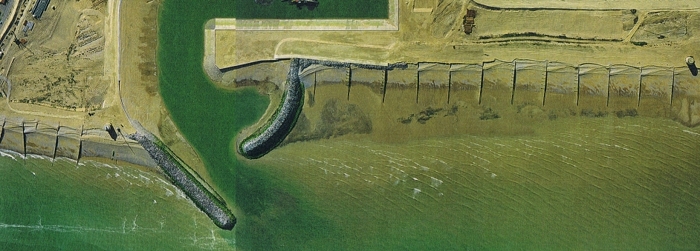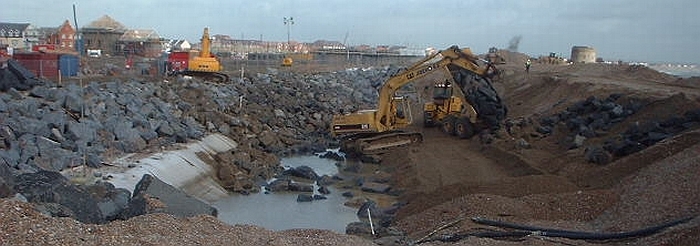Sovereign Harbour
Sea Defence History
The Sovereign Harbour development is situated on an area of Eastbourne known as The Crumbles. Details of The Crumbles’ history can be found in an excellent book by local author Ann Botha in “The Crumbles Story”.
 A harbour and development in its final position was first proposed in the 1960's. Throughout the 60’s & 70’s the Agency’s predecessors petitioned against the proposal because of the detrimental effects they considered the harbour would have on coastal processes and the existing sea defences.
A harbour and development in its final position was first proposed in the 1960's. Throughout the 60’s & 70’s the Agency’s predecessors petitioned against the proposal because of the detrimental effects they considered the harbour would have on coastal processes and the existing sea defences.
Despite this a bill promoting the harbour was deposited in 1980 and enacted as the Eastbourne Harbour Act 1980
 In 1988, harbour developers Tarmac (now Carillion) entered into an agreement with Southern Water for the purpose of safeguarding the sea defences in front of the 3,000 houses that Tarmac were proposing to build as part of the development.
In 1988, harbour developers Tarmac (now Carillion) entered into an agreement with Southern Water for the purpose of safeguarding the sea defences in front of the 3,000 houses that Tarmac were proposing to build as part of the development.
 Following the near failure of the defences during the winter of 1999/2000, in April 2000 the Agency made public its concern over the inadequacy of the sea defences in front of the new housing. The resulting effect on house sales, lead Carillion to make an application for a Judicial Review of the Agency's actions. Following submission of the Agency’s witness statements Carillion agreed to a postponement of the Review hearing pending further negotiations with the Agency.
Following the near failure of the defences during the winter of 1999/2000, in April 2000 the Agency made public its concern over the inadequacy of the sea defences in front of the new housing. The resulting effect on house sales, lead Carillion to make an application for a Judicial Review of the Agency's actions. Following submission of the Agency’s witness statements Carillion agreed to a postponement of the Review hearing pending further negotiations with the Agency.
In August 2001 the Agency signed a new agreement (The Sovereign Harbour Beaches Sea Defence) with Carillon and the Judicial Review was dismissed. Under this agreement initial capital works to bring the defences up to a standard specified by the Agency would be paid for by Carillion and a Trust funded by the residents of Sovereign Harbour. These works would comprise a 450 metre long rock revetment and shingle replenishment costing approximately £2.5 million. The Trust and the Sussex Local Flood Defence Committee (LFDC) would jointly fund the subsequent management of the defences.
 Capital works were completed by the end of November 2001 after which the Agency took over the maintenance of the defences and entered into negotiations with PCDL to include the frontage in the PPP contract. At a meeting held on 2 July 2002 the Agency reached agreement with PCDL to vary the PPP contract to include the Sovereign Harbour Frontage. This agreement was subject to the completion and execution of the relevant change agreement document to the contract. Approval to vary the PPP contract on this basis was obtained from DEFRA in September 2002.
Capital works were completed by the end of November 2001 after which the Agency took over the maintenance of the defences and entered into negotiations with PCDL to include the frontage in the PPP contract. At a meeting held on 2 July 2002 the Agency reached agreement with PCDL to vary the PPP contract to include the Sovereign Harbour Frontage. This agreement was subject to the completion and execution of the relevant change agreement document to the contract. Approval to vary the PPP contract on this basis was obtained from DEFRA in September 2002.
Completion of the negotiations and full agreement on the change document text was achieved on 18 March 2003. At a meeting of the Regional Flood Defence Committee on 9 April 2003, and a special meeting of the Sussex LFDC on 30 April 2003, final approval was given to vary the Pevensey PPP contract to include the Sovereign Harbour Frontage.
Local Effects
It has often been suggested that beach erosion was not a serious problem in Pevensey Bay before Sovereign Harbour was constructed. By and large this is not the case. Erosion had been occurring long before the harbour arms were built in 1993. Historically, the shingle bank that formed The Crumbles had been eroding for at least five hundred years. Initially, as the shingle drifted east, it was sediment released from The Crumbles that helped sustain beaches in Pevensey Bay, Bexhill, Bulverhythe, Hastings and beyond.
Coastal policy for most of the South coast became “Hold the Line” and erosion of The Crumbles was halted, so that the supply of sediment dwindled, and erosion in Pevensey Bay got worse. This was not as a result of the harbour, but of protecting the updrift coastline that had previously been feeding sediment into the system.
Whilst Sovereign Harbour may not have unduly affected coastal processes across Pevensey Bay as a whole, as a non-natural harbour the marina has a significant influence on how the beach behaves between Langney and Pevensey Bay Sailing Club.
- Shingle that used to move by longshore drift from Eastbourne’s beaches and into Pevensey Bay can no longer do so. Instead it builds up on the southern harbour arm and has to be mechanically bypassed round the harbour using road lorries. Some shingle is inevitably lost into the harbour’s entrance channel.

- The harbour’s entrance channel had to be dredged about 2m into the sea bed so vessels could enter the marina at all states of the tide. Being lower than its surroundings, this channel gradually fills with sediment moved by the tide. Consequently, to keep it clear, over 30,000 m³ of material is dredged from it every year, all of which is deposited 2.5km out to sea. This means well over 500,000 m³ has so far been removed from the near shore in this way. It is inevitable that this will have local consequences, since sand and silt are just as important to the overall structure of the sea defence as shingle. There is some evidence that lower foreshore levels are gradually falling, but to some degree that will happen as a natural consequence of a receding coastline.

- Because the harbour arms protrude from the coast out into the sea, they cause waves to refract, focussing their energy just north of the harbour. This results in increased erosion of the beach, particularly between the harbour and Martello tower No.64. Historically the drift rate here was between 5,000 – 10,000 m³ per year before the harbour was constructed. The scour effect created by these refracted waves means it is now closer to 30,000 m³, even with the maintenance recycling and reprofiling that is carried out. Replacing the 20,000 m³ of beach that is lost every year with sea dredged aggregate costs more than £500,000Point 3 in particular means that managing Sovereign Harbour as a stand-alone section of coast would be very expensive.

Because the 1km long frontage is managed as an integral part of the 9km long Pevensey Bay frontage, these costs can be mitigated since money spent here can be shown to add value to the coast as a whole. Pevensey Bay, Bexhill, Bulverhythe and Hastings all need a flow of shingle moving along the coast in order to maintain their own beach alignments. Adding sediment to the system at Sovereign Harbour, and managing it as it drifts west to east, maximises the length of coast to benefit overall. In this instance, using public money to help maintain the beach of a private development does make sense.




